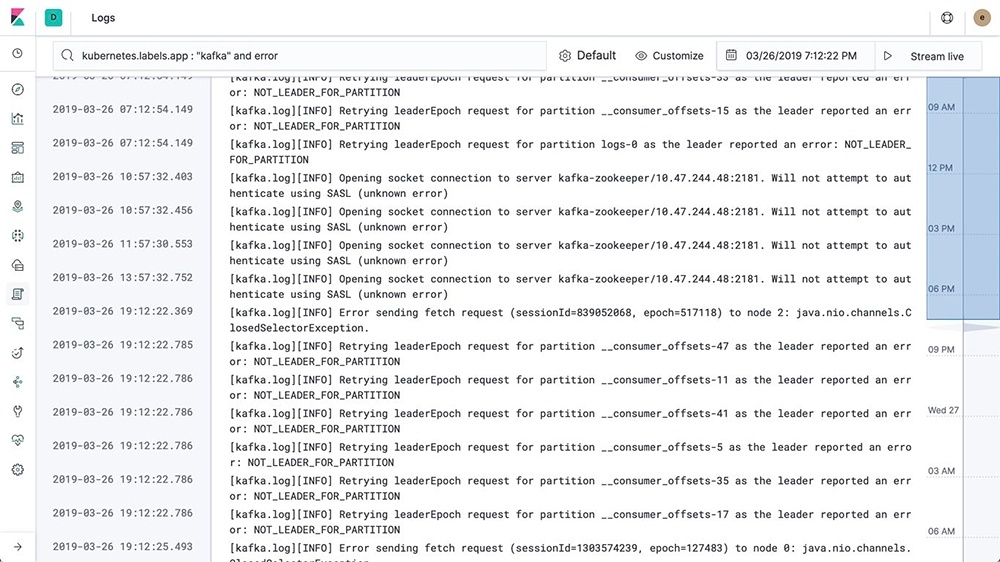Free & Open Source Logging: Top Tools for Effective Server Monitoring in 2025
At RobotAlp, we highlight that effective system monitoring isn't complete without log management, where open-source tools turn overwhelming server logs into clear, actionable insights—efficiently and affordably.

Free & Open Source Logging: Top Tools for Effective Server Monitoring in 2025
Hello fellow tech enthusiasts, developers, and system administrators! When we, at RobotAlp, talk about comprehensive server and website oversight, we often focus on crucial aspects like Uptime Monitoring or understanding the nuances of Server Monitoring. These are vital for knowing if your services are accessible. However, there's another layer to truly understanding your system's health and behavior: log management. While many might rely on basic server outputs or bundled hosting tools, the world of free and open-source log management offers powerful capabilities that can transform noisy log files into actionable intelligence, often without the hefty price tag of commercial enterprise solutions.
The sheer volume of data generated by today's applications, servers, containers, and cloud services can be staggering. Yet, hidden within these torrents of text are the clues needed to troubleshoot issues, optimize performance, detect security anomalies, and ensure compliance. This article will guide you through some of the top free and open-source log management and analysis tools available in 2025, helping you choose the right solutions to effectively monitor your systems.
The Core Concepts: Log Aggregation & Analysis
Before diving into the tools, it's essential to grasp the two fundamental pillars of effective log management:
- Log Aggregation: This is the systematic collection of log data from a multitude of sources (applications, infrastructure components, containers, cloud services, etc.) into a centralized repository. Once gathered, these logs are typically parsed (to give them structure), enriched (to add contextual information), and stored efficiently for later use.
- Log Analysis: This involves querying, visualizing, and correlating the aggregated logs to identify patterns, detect anomalies, troubleshoot problems, and gain operational insights.
Together, these processes are foundational to observability, turning raw data into the wisdom needed to keep systems healthy and performant.
A Comprehensive Look at Free & Open Source Logging Tools for 2025
The open-source realm provides a diverse array of tools, from all-in-one platforms to specialized collectors and viewers. Here’s an exploration of prominent options based on current research and their capabilities:
1. Elastic Stack (ELK) / OpenSearch
- Overview: A widely adopted powerhouse for centralized log management, consisting of Elasticsearch (search and indexing engine), Logstash (log collection and processing), and Kibana (visualization). Following Elasticsearch and Kibana's license changes in 2021, OpenSearch (and OpenSearch Dashboards) emerged as a fully Apache 2.0 licensed open-source fork, often preferred by those seeking to avoid the SSPL. SOF-ELK® is a notable customized build of the Elastic stack tailored for forensic investigators and security operations personnel, simplifying the typically complex setup.
- Key Features: Powerful full-text search, filtering, and a rich query language. Highly scalable for large log volumes. Kibana/OpenSearch Dashboards enable visualization, dashboard creation, and real-time monitoring. Supports various data shippers like Beats. Alerting mechanisms for specific log patterns.
- Use Cases: Ideal for large-scale centralized log management. Used for debugging application errors, security incident investigation, and user activity tracking.
- Platforms: Java-based (Elasticsearch/OpenSearch, Logstash), works on Linux, Windows, etc. Kibana/Dashboards are web-based.
- Considerations: Can be resource-intensive and complex to manage, especially at scale.

2.Graylog
- Overview: A comprehensive open-source log management platform designed for centralized log collection, storage, and analysis with a full-featured web interface. It typically uses Elasticsearch/OpenSearch as its storage backend and MongoDB for metadata.
- Key Features: End-to-end log management capabilities. Powerful search leveraging Elasticsearch with a user-friendly UI. "Streams" and "Pipelines" for real-time log categorization and sophisticated processing rules. Built-in alerting system and "Content Packs" for common log sources to accelerate setup. Supports GELF, Syslog, Beats, and other inputs.
- Use Cases: Often used as an enterprise log hub for operational monitoring, security auditing, SIEM-like functionalities, and compliance scenarios.
- Platforms: Server is Java-based (typically Linux). Web interface is browser-accessible.

3.Grafana Loki
- Overview: A horizontally-scalable, cloud-native log aggregation system developed by Grafana Labs, inspired by Prometheus. Loki's innovative approach is to index only metadata (labels) associated with log streams rather than the full log content, dramatically reducing storage requirements and costs.
- Key Features: Extremely efficient and cost-effective storage. Log analysis and visualization are primarily done via Grafana. Uses LogQL, a query language inspired by PromQL, for filtering by labels first, then searching content. Excellent integration with Prometheus (shares the same label model). Scales horizontally and works well with object storage (S3, GCS).
- Use Cases: Ideal for cloud and microservice environments, especially Kubernetes (can leverage pod metadata as labels). Teams already using Grafana and Prometheus will find it a natural fit. A cost-effective alternative when Elasticsearch-based solutions become too expensive or operationally complex.
- Platforms: Go-based, runs on Linux, Windows, and in containers. Typically deployed with Promtail (Loki's log shipper).
- Considerations: Full-text search capabilities are more limited compared to Elasticsearch; performs best with well-labeled logs.

4.Fluentd & Fluent Bit
- Overview: A unified logging layer for collecting, filtering, and routing log data. Fluentd is a CNCF-graduated project with extensive plugin support. Fluent Bit is its lightweight, high-performance counterpart, optimized for minimal resource usage, making it ideal for edge devices, containers, and IoT. Both primarily focus on log aggregation and transport, not native analysis.
- Key Features (Fluentd): Over 500 plugins for inputs, filters, and outputs. Real-time processing (parsing, renaming fields, filtering).
- Key Features (Fluent Bit): Minimal footprint (~4MB binary), high throughput (hundreds of thousands of events/sec).
- Strengths: Highly efficient, flexible (decouples producers from storage), excellent for cloud-native (Kubernetes) environments, widely adopted.
- Use Cases: Standard for log collection in distributed architectures, forwarding logs from containers/nodes to centralized systems like Elasticsearch, Loki, or SigNoz. Fluent Bit is preferred for resource-constrained environments.
- Platforms: Fluentd (CRuby/mruby, typically Linux/Unix). Fluent Bit (C/C++, multi-platform including Windows).
- External Links: Fluentd Official Site

5. SigNoz
- Overview: An open-source observability platform providing integrated log management, metrics monitoring, and distributed tracing. Based on OpenTelemetry and a columnar database, it offers both aggregation and analysis in a single tool.
- Key Features: Unified observability (logs, metrics, traces correlated). OpenTelemetry native. High-performance queries with columnar database. One-command setup (Docker Compose/Helm). Uses OpenTelemetry Collector for ingestion, also accepts logs from Fluentd, Logstash, etc.. Intuitive logs explorer with a powerful query builder, saved views, dashboards, and alerting.
- Use Cases: Organizations seeking an open-source alternative to Datadog, needing correlated analysis of logs, metrics, and traces, or an all-in-one on-premise solution.
- Platforms: Docker/Kubernetes.

6.Syslog-ng
- Overview: A mature, high-performance log collection and forwarding tool, often an enhanced replacement for traditional syslog daemons. Strong in enterprise and network device logging. Primarily focuses on aggregation and forwarding.
- Key Features: Extremely fast (can process 600k-800k messages/sec/node). Reliable transport with disk-based buffering. Sophisticated message classification and filtering. Security features (TLS, message signing). Supports various formats (Syslog, JSON, systemd Journald) and transport protocols (UDP, TCP, TLS, RELP).
- Use Cases: Centralizing logs from network devices, system logs, and syslog-supporting applications. Often the first hop in a pipeline, forwarding to Elasticsearch or Kafka.
- Platforms: Primarily Linux/Unix.
- External Link: Syslog-ng (OneIdentity/Quest)

7.Uptrace
- Overview: An open-source log management and distributed tracing tool that correlates logs with trace data, especially for microservices. Supports OpenTelemetry.
- Key Features: Advanced log analysis, real-time search, intelligent log correlation with traces for faster debugging. Automated log pattern detection, customizable dashboards, and alerting. SQL-like query language for logs.
- Use Cases: Debugging in complex microservice architectures, correlating logs with distributed traces to find root causes.
- Platforms: Server (Go) runs on Linux/macOS, Docker/K8s.

8.Nagios Log Server (Part of Nagios Core/XI ecosystem)
- Overview: Nagios, a veteran IT infrastructure monitoring tool, offers Nagios Log Server for centralized log collection, analysis, and alerting.
- Key Features: Real-time data capture, powerful search tool, setup wizard for easy integration. Network event auditing, automated alert distribution, can run predefined scripts on alert conditions. Geo-location filtering.
- Use Cases: Organizations needing to monitor network security, audit network events, and automate responses to specific log conditions. Integrates with other Nagios monitoring.
- Platforms: Server typically Linux; can monitor Windows, Linux, Unix.
- Considerations: Can be tedious to scale; older architecture compared to some modern tools.

Specialized & Command-Line Focused Open Source Tools
These tools often serve specific niches or provide powerful capabilities directly in the terminal:
- Logwatch: A simple, periodic log analyzer (often default on Linux) that generates email summary reports. Not real-time or centralized but good for basic server health overviews.
- GoAccess: A real-time web log analyzer (Apache, Nginx, etc.) that runs in the terminal or generates HTML reports. Excellent for quick HTTP statistics. Website: goaccess.io
- Lnav (The Logfile Navigator): A terminal-based advanced log file viewer that can merge, tail, search, filter, and even query log files using SQL. No server setup needed. Website: lnav.org
- Angle-Grinder: A command-line tool for parsing, aggregating, and performing sophisticated analytics on log files directly in the terminal using a functional processing language. Website: GitHub - rcoh/angle-grinder
- LogHog: Log Analyzer: A Python-based log analyzer with a customTkinter GUI, an evolution of "Logator." Features include Syslog analysis, authentication analysis, and comparing log file contents/hashes side-by-side.
- Vector: An ultra-fast, Rust-based observability data pipeline for collecting, transforming, and routing logs and metrics to various destinations. Website: vector.dev
- Parseable: A cloud-native log observability engine written in Rust, using Apache Arrow and Parquet. Features an index-free design for rapid ingestion and retrieval.
- Log Owl: An error tracking tool with a self-hosted open-source option, providing insights and detailed analytics with a focus on user privacy.
- Sentry: While primarily an error tracking and application performance monitoring platform, Sentry has a strong open-source core and handles application-level logs/events with rich context. Excellent for developers.
- OpenObserve: A Rust-based open-source platform aiming to be an all-in-one solution for logs, metrics, and traces, offering efficient storage and SQL for querying logs. Website: OpenObserve.ai
- Highlight.io: An open-source, full-stack monitoring platform combining session replay, error tracking, and logging. Website:
Overview of Selected Open Source Logging Tools
Key Considerations When Choosing Open Source Logging Tools:
- Scalability: Can the tool handle your current and future log volume?
- Features: Does it offer real-time monitoring, advanced analytics, alerting, and the specific parsing capabilities you need?
- Ease of Use & Learning Curve: How intuitive is the interface? How much effort will be required for setup, configuration, and maintenance?
- Community & Documentation: Is there active community support and comprehensive documentation available?
- Integration Capabilities: How well does it integrate with your existing infrastructure, applications, and other monitoring tools?
- Resource Consumption: Some tools, especially older Java-based ones like Logstash, can be resource-heavy. Newer tools written in Go or Rust (like Loki, Vector, OpenObserve, Parseable) often prioritize efficiency.
Conclusion: Leveraging Open Source for Powerful Log Insights
The landscape of free and open-source logging tools in 2025 is rich and diverse, offering powerful solutions for organizations of all sizes. Whether you need a simple log shipper, a real-time web log analyzer, or a comprehensive observability platform, there's likely an open-source option that can meet your needs without the hefty licensing fees of proprietary software.
By understanding your specific requirements and carefully evaluating the strengths of these tools, you can build an effective log management strategy. This will not only help you troubleshoot issues faster but also provide valuable insights for optimizing performance, enhancing security, and making better data-driven decisions. Remember, effective logging is a cornerstone of a well-monitored and reliable system.




